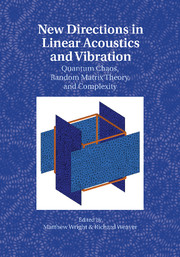Book contents
- Frontmatter
- Contents
- Foreword by Michael Berry
- Introduction
- 1 The Semiclassical Trace Formula
- 2 Wave Chaos for the Helmholtz Equation
- 3 The Unreasonable Effectiveness of Random Matrix Theory for the Vibrations and Acoustics of Complex Structures
- 4 Gaussian Random Wavefields and the Ergodic Mode Hypothesis
- 5 Short Periodic Orbit Theory of Eigenfunctions
- 6 Chaotic Wave Scattering
- 7 Transfer Operators Applied to Elastic Plate Vibrations
- 8 Mesoscopics in Acoustics
- 9 Diagrammatic Methods in Multiple Scattering
- 10 Time-Reversed Waves in Complex Media
- 11 Ocean Acoustics: A Novel Laboratory for Wave Chaos
- 12 Mesoscopic Seismic Waves
- 13 Random Matrices in Structural Acoustics
- 14 The Analysis of Random Built-Up Engineering Systems
- References
- Index
Introduction
Published online by Cambridge University Press: 05 October 2010
- Frontmatter
- Contents
- Foreword by Michael Berry
- Introduction
- 1 The Semiclassical Trace Formula
- 2 Wave Chaos for the Helmholtz Equation
- 3 The Unreasonable Effectiveness of Random Matrix Theory for the Vibrations and Acoustics of Complex Structures
- 4 Gaussian Random Wavefields and the Ergodic Mode Hypothesis
- 5 Short Periodic Orbit Theory of Eigenfunctions
- 6 Chaotic Wave Scattering
- 7 Transfer Operators Applied to Elastic Plate Vibrations
- 8 Mesoscopics in Acoustics
- 9 Diagrammatic Methods in Multiple Scattering
- 10 Time-Reversed Waves in Complex Media
- 11 Ocean Acoustics: A Novel Laboratory for Wave Chaos
- 12 Mesoscopic Seismic Waves
- 13 Random Matrices in Structural Acoustics
- 14 The Analysis of Random Built-Up Engineering Systems
- References
- Index
Summary
This book has some of its genesis in the, possibly apocryphal, story that at an acoustics conference in the late 1980s a certain distinguished professor, tiring of the proceedings, turned to the assembled researchers and announced
Listen! If what you're doing isn't nonlinear or transonic, then don't bother! It's all been done!
Certainly it has become easy to think of linear acoustics as essentially completed. After all, classic texts such as Morse and Feshbach (1953) give admirably thorough expositions of very general techniques, particularly those based on Green's functions. Cases described by coordinate systems in which the governing equations are separable are extensively tabulated and admit analytic solutions. The alternative is to employ numerical methods, many of them also based on Green's functions, which work in arbitrarily complex geometries. There is perhaps a perception that notwithstanding a host of important applied problems, there are no fundamental issues remaining in linear acoustics. Increased understanding of the richness and complexity of nonlinear problems with the explosion of interest in chaos only serves to make linear systems seem “done and dusted” in comparison.
And yet this picture is overly dismissive. A solution of a linear differential equation depends nonlinearly on its coefficients and the shape of the boundary. The dependence is all the richer if those coefficients are random or if boundary reflections are defocusing. Developments in physics throughout the last four decades, often equally applicable to both quantum and linear acoustic problems, but overwhelmingly more often expressed in the language of the former, have explored this.
Information
- Type
- Chapter
- Information
- New Directions in Linear Acoustics and VibrationQuantum Chaos, Random Matrix Theory and Complexity, pp. 1 - 4Publisher: Cambridge University PressPrint publication year: 2010
